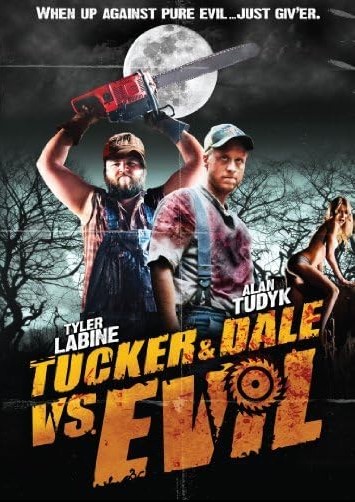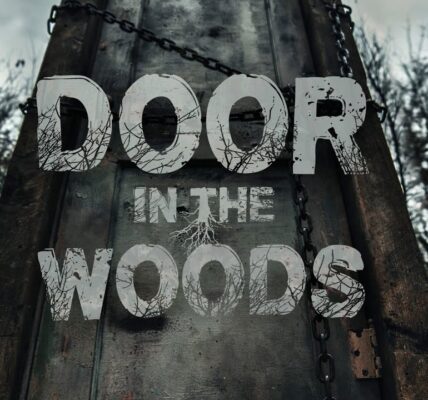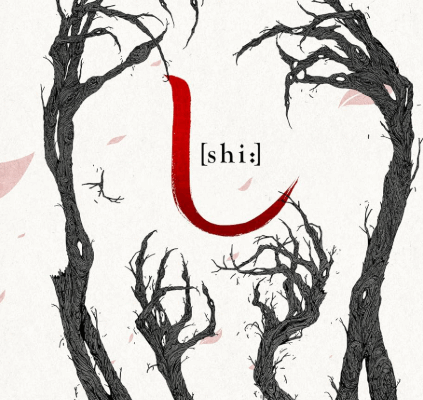1. Plot Summary (Spoiler-Light)
Tucker & Dale are two affable, good-hearted hillbillies who have recently bought a run-down cabin in the woods. Their plan: fix it up, drink some beer, fish, and generally enjoy a peaceful weekend.
Meanwhile a group of college students head into the same woods for a camping trip. When Allison (one of the students) nearly drowns, Tucker & Dale rescue her, but the students misinterpret every action thereafter — thinking Tucker & Dale are evil killers. The rest of the film is a cascade of misunderstandings, accidents, gore, and mayhem, as each side misreads the other’s intentions. The college kids try to “rescue” Allison, often against their own injuries, leading to absurd, often gruesome, comedic outcomes.
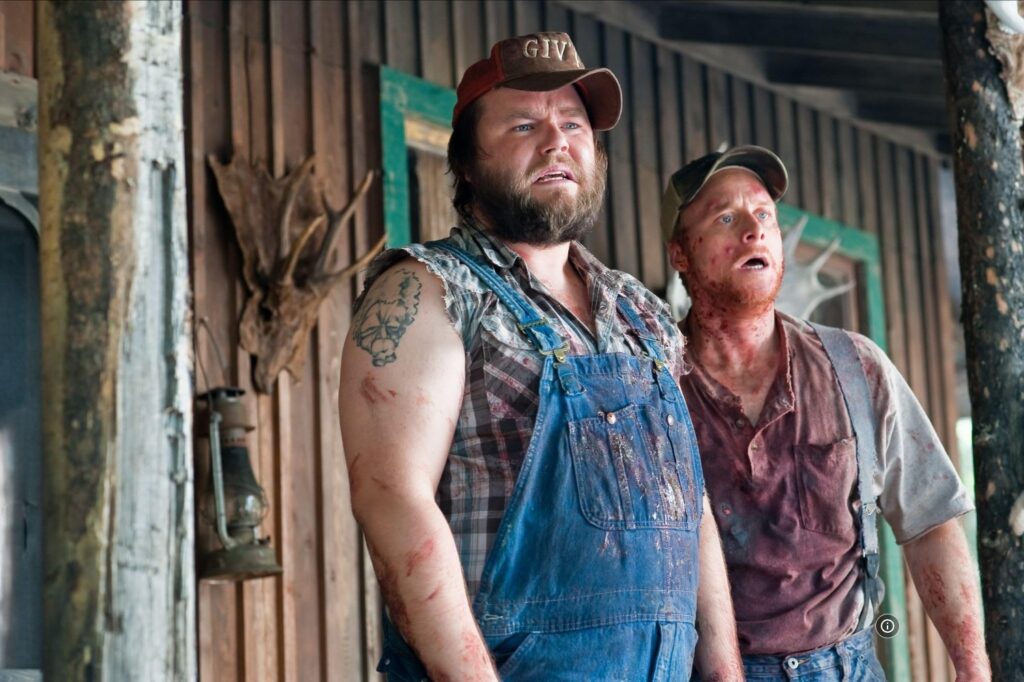
2. Notable Elements
- Subversion of Tropes
The film flips the “evil hillbillies vs outsiders” trope on its head. Normally, hillbillies are villains in horror; here, they’re the innocent ones, trying to do good but constantly being misjudged. - Comedy + Horror Balance
The gore is real (people getting impaled, accidents, the wood-chipper, etc.), but they play it for dark, slapstick comedy rather than pure terror. It’s violent, but the violence is often absurd, which makes it funny. - Characters with Heart
Despite being goofy horror fodder, Tucker and Dale are written with likability, kindness, and even vulnerability — especially Dale, who worries he isn’t good enough and is socially awkward around Allison. - Misunderstanding as the Engine
Many of the set-pieces are built around misunderstandings — hearing things out of context, seeing one thing and assuming another. That leads to tragic accidents and comedic chaos. The film leans into this structure heavily. - Visual & Situational Comedy
Scenes like Tucker accidentally disturbing a beehive with a chainsaw, or students running into their own hazards while fleeing, are both horrifying and ridiculous. These are standout moments.
3. Themes & Messages
- Judgment & Prejudice
A major theme is “don’t judge a book by its cover.” The college students assume Tucker & Dale are evil based on appearance and stereotypes, whereas they are in reality friendly and harmless. - Fear of the Unknown / Miscommunication
How easily things escalate when people misunderstand or don’t communicate. Much of the horror here comes not from a monster but from misunderstanding and fear. - Friendship & Innocence
Tucker & Dale’s relationship is one of loyalty and care — their friendship gives grounding to what might otherwise be just gore comedy. Dale’s unguarded crush on Allison adds some romantic sweetness. - Parody & Genre Commentary
The movie acts as both homage to and parody of classic slasher / backwoods horror films. It uses familiar settings and tropes (remote cabin, woods, scary legends, camping students) and then inverts expectations. - Consequences of Assumption & Escalation
One small error (an accident) quickly escalates into chaos — demonstrating how panic and assumption can lead to tragic results even without true malice.
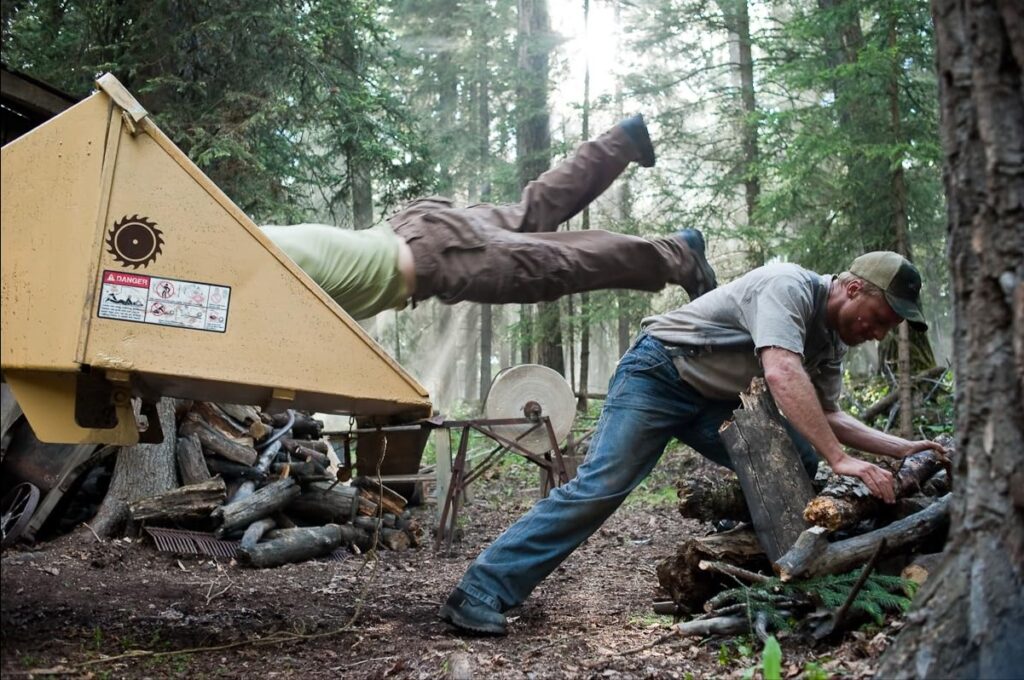
4. Personal Impressions
What works really well:
- The humor is sharp. It laughs with but also at horror conventions. I found many scenes genuinely funny — especially those built on misunderstandings.
- The leads, Tyler Labine (Dale) and Alan Tudyk (Tucker), bring charm. They avoid being one-dimensional “redneck caricatures” and instead are sympathetic.
- The gore effects are well done — enough to satisfy horror fans, but integrated into comedic chaos rather than just shock value.
- The pacing is good. The film wastes little time before things go off the rails, but it also gives enough breathing room for character moments and setups so the humor and horror both land.
What’s less strong / potential weak points:
- Some of the deaths / accidents are so absurd that they may pull you out of suspension of disbelief. If you prefer horror that stays grounded, this might feel too silly.
- The college students are mostly stock characters (frat boys, the “mean girl,” etc.). They are designed as clichés in many cases, which works for parody, but limits emotional depth.
- The ending, while satisfying in a comedic-horror way, may not feel as emotionally strong for some; the film is more about laughs + twist than deep resolution.
- If you’re not into gore or dark humor, some scenes may be uncomfortable. The violence can be pretty graphic, even if comedic.
5. Audience Recommendations
You’ll likely enjoy Tucker & Dale vs. Evil if you like:
- Horror comedy / spoofs of slasher tropes. If you’ve seen Cabin in the Woods, Shaun of the Dead, or other horror films that poke fun at the genre, this is in that territory.
- Films that subvert expectations — basically, you enjoy seeing the “villain” turn out not to be the bad guy, or misunderstandings being the real source of tension.
- Comedic kills, gore, and absurd situations — if you like dark humor + blood + ridiculousness, this is a great blend.
- Good character chemistry and friendly, even sweet moments amid the chaos.
It’s less good for you if you prefer horror that’s purely scary, or want minimal gore, or want your characters to be highly developed with complex arcs.
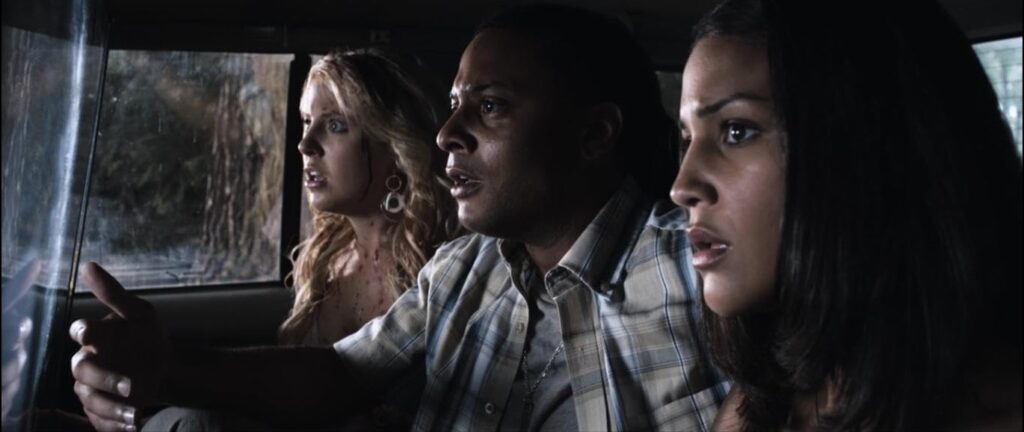
6. Conclusion & Rating
Final Thoughts:
Tucker & Dale vs. Evil is one of the more clever horror-comedies out there. It takes a familiar setup — cabin in the woods, hillbillies, college kids — and shakes it up in hilarious, bloody, and emotionally satisfying ways. The misunderstandings are well-designed, the performances are warm, and even when things get gross, they feel earned in the context of the tone. It’s a film that delivers laughs and scares, but also has a heart underneath the chaos.
Rating: ★★★★☆ (4.0 / 5)
